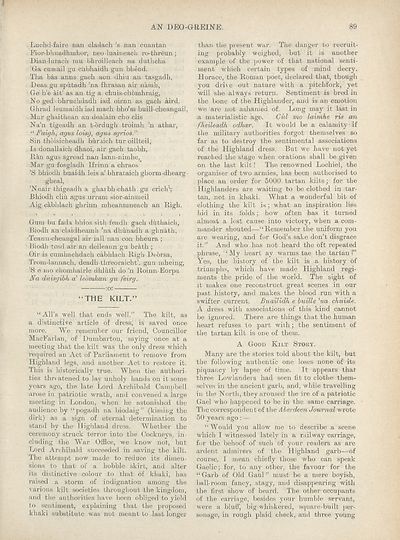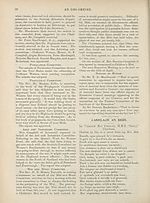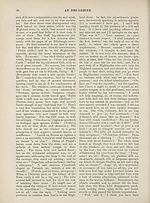An Comunn Gàidhealach Publications > Deo-gréine > Volume 10, October 1914-September 1915
(97) Page 89
Download files
Complete book:
Individual page:
Thumbnail gallery: Grid view | List view

AN DEO-GREINE.
Luohd-faire nan cladach’s nan cuantan
Fioivblmadhmhor, neo luaineacii rothreun ;
Dian-lurack mu bhroilleach na dutheha
’Ga cumail gu cubhaidk gun bli-eud.
Tha bas anns gach aon dhia an tasgadli,
Deas gu sputadh ;na fhrasan air namh,
• Ge‘ b’e ait’ as an tig a chuis-chbmhraig,
No ged bhruchdadh iad oirnn as gach aird.
Ghrad leumaidh iad mach bho’m buill-cheangail,
Mar ghaithean an dealain cho clis
Na’n tigeadh an t-brdugh troimh ’n athar,
“ Faigh, agus loisg, agus sgrios.’’
Sin thbisicheadli buraich turoillteil,
Is donallaich dhaoi, air gach taobh.
Ran agus sgread nan lann-nimhe,
Mar gu fosgladh Ifrinn a chraos
’S bhiodh buaidh leis a’ bhrataich glmnn-dhearg-
gheal,
’Nuair thigeadh a gharbh-chatb gu crich1;
Bhiodh cliii agus urram sior-ainmeil
Aig cabhlach ghrinn mheanumeach an High.
Gum bu fada bhios sith feadh gach diithaicli,
Biodh an claidheamli ’na dhunadh a ghniith,
Teann-cheangal air iall nan con bheura ;
Biodh tosd air an deileann gu brath ;
Qir is cumhachdach cabhlach Righ Dcbrsa,
Trom-lannach, deadh threoraicht’. gun mheing,
’S e mo chomhairle dhluth do ’n Roinn-Eorpa
Fa duisgibh a' lebmhan gu feirg.
•THE KILT.”
“All’s well that ends well.” The kilt, as
a distinctive article of dress, is saved once
more. We remember our friend, Councillor
MacFarlan, of Dumbarton, saying once at a
meeting that the kilt was the only dress which
required an Act of Parliament to remove from
Highland legs, and another Act to restore it.
This is historically true. When the authori¬
ties threatened to lay unholy hands on it some
years ago, the late Lord Archibald Campbell
arose in patriotic wrath, and convened a large
meeting in London, when he astonished the
audience by “ pogadh na biodaig ” (kissing the
dirk) as a sign of eternal determination to
stand by the Highland dress. Whether the
ceremony struck terror into the Cockneys, in¬
cluding the War Offlce, we know not, but
Lord Archibald succeeded in saving the kilt.
The attempt now made to reduce its dimen¬
sions to that of a hobble skirt, and alter
its distinctive colour to that of khaki, has
raised a storm of indignation among the
various kilt societies throughout the kingdom,
and the authorities have been obliged to yield
to sentiment, explaining that the proposed
khaki substitute was not meant to last longer
than the present war. The danger to recruit¬
ing probably weighed, but it is another
example of the power of that national senti¬
ment which certain types of mind decry.
Horace, the Roman poet, declared that, though
you drive out nature with a pitchfork, yet
will she always return. Sentiment is bred in
the bone of the Highlander, and is an emotion
we are not ashamed of. Long may it last in
a materialistic age. Cul mo laimhe ris an
fheileadh odhar. It would be a calamity if
the military authorities forgot themselves so
far as to destroy the sentimental associations
of the Highland dress. But we have not yet
reached the stage when orations shall be given
on the last kilt! The renowned Lochiel, the
organiser of two armies, has been authorised to
place an order for 5000 tartan kilts; for the
Highlanders are waiting to be clothed in tar¬
tan, not in khaki. What a wonderful bit of
clothing the kilt is; what an inspiration lies
hid in its folds; how often has it turned
almost a lost cause into victory, when a com¬
mander shouted—“Remember the uniform you
are wearing, and for God’s sake don’t disgrace
it.” And who has not heard the oft repeated
phrase, “My heart ay warms tae the tartan?”
Yes, the history of the kilt is a history of
triumphs, which have made Highland regi¬
ments the pride of the world. The sight of
it makes one reconstruct great scenes in our
past history, and makes the blood run with a
swifter current. Buailidh e buille ’na chuisle.
A dress with associations of this kind cannot
be ignored. There are things that the human
heart refuses to part with; the sentiment of
the tartan kilt is one of them.
A Good Kilt Story.
Many are the stories told about the kilt, but
the following authentic one loses none of its
piquancy by lapse of time. It appears that
three Lowlanders had seen fit to clothe them¬
selves in the ancient garb, and, while travelling
in the North, they aroused the ire of a patriotic
Gael who happened to be in the same carriage.
The correspondent of the Aberdeen Journal wrote
50 years ago : —
“ Would you allow me to describe a scene
which I witnessed lately in a railway carriage,
for the behoof of such of your readers as are
ardent admirers of the Highland garb—of
course, I mean chiefly those who can speak
Gaelic; for, to any other, the favour for the
“Garb of Old Gaul” must be a mere boyish,
ball-room fancy, stagy, and disappearing with
the first show of beard. The other occupants
of the carriage, besides your humble servant,
were a bluff', big-whiskered, square-built per¬
sonage, in rough plaid check, and three young
Luohd-faire nan cladach’s nan cuantan
Fioivblmadhmhor, neo luaineacii rothreun ;
Dian-lurack mu bhroilleach na dutheha
’Ga cumail gu cubhaidk gun bli-eud.
Tha bas anns gach aon dhia an tasgadli,
Deas gu sputadh ;na fhrasan air namh,
• Ge‘ b’e ait’ as an tig a chuis-chbmhraig,
No ged bhruchdadh iad oirnn as gach aird.
Ghrad leumaidh iad mach bho’m buill-cheangail,
Mar ghaithean an dealain cho clis
Na’n tigeadh an t-brdugh troimh ’n athar,
“ Faigh, agus loisg, agus sgrios.’’
Sin thbisicheadli buraich turoillteil,
Is donallaich dhaoi, air gach taobh.
Ran agus sgread nan lann-nimhe,
Mar gu fosgladh Ifrinn a chraos
’S bhiodh buaidh leis a’ bhrataich glmnn-dhearg-
gheal,
’Nuair thigeadh a gharbh-chatb gu crich1;
Bhiodh cliii agus urram sior-ainmeil
Aig cabhlach ghrinn mheanumeach an High.
Gum bu fada bhios sith feadh gach diithaicli,
Biodh an claidheamli ’na dhunadh a ghniith,
Teann-cheangal air iall nan con bheura ;
Biodh tosd air an deileann gu brath ;
Qir is cumhachdach cabhlach Righ Dcbrsa,
Trom-lannach, deadh threoraicht’. gun mheing,
’S e mo chomhairle dhluth do ’n Roinn-Eorpa
Fa duisgibh a' lebmhan gu feirg.
•THE KILT.”
“All’s well that ends well.” The kilt, as
a distinctive article of dress, is saved once
more. We remember our friend, Councillor
MacFarlan, of Dumbarton, saying once at a
meeting that the kilt was the only dress which
required an Act of Parliament to remove from
Highland legs, and another Act to restore it.
This is historically true. When the authori¬
ties threatened to lay unholy hands on it some
years ago, the late Lord Archibald Campbell
arose in patriotic wrath, and convened a large
meeting in London, when he astonished the
audience by “ pogadh na biodaig ” (kissing the
dirk) as a sign of eternal determination to
stand by the Highland dress. Whether the
ceremony struck terror into the Cockneys, in¬
cluding the War Offlce, we know not, but
Lord Archibald succeeded in saving the kilt.
The attempt now made to reduce its dimen¬
sions to that of a hobble skirt, and alter
its distinctive colour to that of khaki, has
raised a storm of indignation among the
various kilt societies throughout the kingdom,
and the authorities have been obliged to yield
to sentiment, explaining that the proposed
khaki substitute was not meant to last longer
than the present war. The danger to recruit¬
ing probably weighed, but it is another
example of the power of that national senti¬
ment which certain types of mind decry.
Horace, the Roman poet, declared that, though
you drive out nature with a pitchfork, yet
will she always return. Sentiment is bred in
the bone of the Highlander, and is an emotion
we are not ashamed of. Long may it last in
a materialistic age. Cul mo laimhe ris an
fheileadh odhar. It would be a calamity if
the military authorities forgot themselves so
far as to destroy the sentimental associations
of the Highland dress. But we have not yet
reached the stage when orations shall be given
on the last kilt! The renowned Lochiel, the
organiser of two armies, has been authorised to
place an order for 5000 tartan kilts; for the
Highlanders are waiting to be clothed in tar¬
tan, not in khaki. What a wonderful bit of
clothing the kilt is; what an inspiration lies
hid in its folds; how often has it turned
almost a lost cause into victory, when a com¬
mander shouted—“Remember the uniform you
are wearing, and for God’s sake don’t disgrace
it.” And who has not heard the oft repeated
phrase, “My heart ay warms tae the tartan?”
Yes, the history of the kilt is a history of
triumphs, which have made Highland regi¬
ments the pride of the world. The sight of
it makes one reconstruct great scenes in our
past history, and makes the blood run with a
swifter current. Buailidh e buille ’na chuisle.
A dress with associations of this kind cannot
be ignored. There are things that the human
heart refuses to part with; the sentiment of
the tartan kilt is one of them.
A Good Kilt Story.
Many are the stories told about the kilt, but
the following authentic one loses none of its
piquancy by lapse of time. It appears that
three Lowlanders had seen fit to clothe them¬
selves in the ancient garb, and, while travelling
in the North, they aroused the ire of a patriotic
Gael who happened to be in the same carriage.
The correspondent of the Aberdeen Journal wrote
50 years ago : —
“ Would you allow me to describe a scene
which I witnessed lately in a railway carriage,
for the behoof of such of your readers as are
ardent admirers of the Highland garb—of
course, I mean chiefly those who can speak
Gaelic; for, to any other, the favour for the
“Garb of Old Gaul” must be a mere boyish,
ball-room fancy, stagy, and disappearing with
the first show of beard. The other occupants
of the carriage, besides your humble servant,
were a bluff', big-whiskered, square-built per¬
sonage, in rough plaid check, and three young
Set display mode to:
![]() Universal Viewer |
Universal Viewer | ![]() Mirador |
Large image | Transcription
Mirador |
Large image | Transcription
| An Comunn Gàidhealach > An Comunn Gàidhealach Publications > Deo-gréine > Volume 10, October 1914-September 1915 > (97) Page 89 |
|---|
| Permanent URL | https://digital.nls.uk/125240628 |
|---|
| Description | Leabhar 10, Mìos Deireannach an Fhogharaidh 1914 gu Darna Mìos an Fhogharaidh 1915 |
|---|---|
| Attribution and copyright: |
|
| Description | This contains items published by An Comunn, which are not specifically Mòd-related. It includes journals, annual reports and corporate documents, policy statements, educational resources and published plays and literature. It is arranged alphabetically by title. |
|---|
| Description | A collection of over 400 items published by An Comunn Gàidhealach, the organisation which promotes Gaelic language and culture and organises the Royal National Mòd. Dating from 1891 up to the present day, the collection includes journals and newspapers, annual reports, educational materials, national Mòd programmes, published Mòd literature and music. |
|---|---|
| Additional NLS resources: |
|

